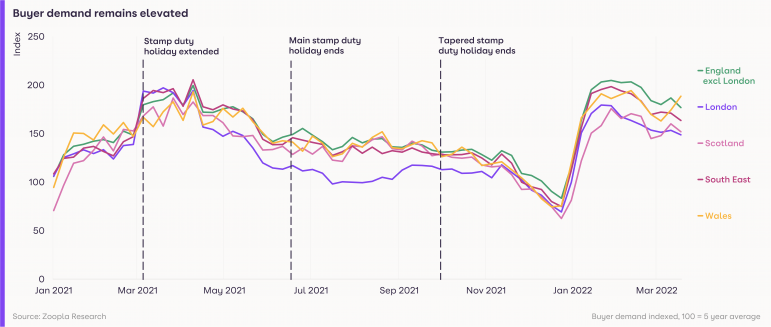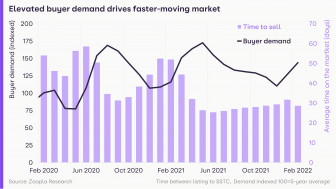
Buyer demand has remained unseasonably strong throughout the first three months of the year. As the chart below shows, buyers’ appetite for homes is competing with levels seen last year when the stamp duty holiday was extended in March, a move which offered many more purchasers the chance to benefit from the tax break.
Pandemic-led trends are still driving the market, with lockdowns prompting many homemovers to seek a different space in which to live, and changed working practices for office-based workers offering the chance to live in a different location.
A bounce in demand in some of the UK’s key cities has also bolstered the market into February and March – demand has risen 5% in Birmingham and 7% in Newcastle since January, with a 20% rise in Blackpool and a 19% increase in Swindon.
There has been a growing narrative around those who moved ‘out’ of cities during lockdown now starting to move ‘back’. While this may be the case for some movers, buyer demand is not always ‘either/or’ – our data shows that demand remains strong in rural areas, especially for family houses.
Even in the face of such strong demand which can quickly erode new supply, the level of homes being listed for sale is continuing to edge up – it is now 5% higher than the five-year average.
This means buyers, and especially those moving home, now have more choice when it comes to finding a new property. One factor making sellers hesitant to list their homes in recent months has been the concern that they wouldn’t find a home to move to before their own home is sold. The rising supply of homes for sale, although modest, could facilitate more sales.
The levels of activity in the market has certainly resulted in everything moving more quickly – the average time between listing and sale agreed is now at 29 days.
Yet the rise in supply is unlikely to be enough to unwind the total imbalance between the stock of homes available for sale and buyer demand, a factor which continues to drive price growth, and will likely continue to put a floor under pricing during the rest of the year.
Average house prices have risen by 8.1% over the last year, and by more than 21% over the last five years. The current levels of buyer demand means homeowners wanting to lock in these gains may be in pole position. Buyers too can still lock into low mortgage rates as competition between lenders remains strong.
As we move through 2022 however, stronger economic headwinds and rising costs will start to put downward pressure on pricing, although we expect that house price growth will remain in positive territory by the end of the year.


